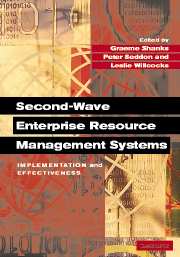Book contents
- Frontmatter
- Contents
- List of Contributors
- Introduction: ERP – The Quiet Revolution?
- Part I Implementation and Effectiveness: Overview
- Part II From Risks to Critical Success Factors
- Part III From Learning to Knowledge
- 10 Implementing Enterprise Resource Planning Systems: The Role of Learning from Failure
- 11 ERP Projects: Good or Bad for SMEs?
- 12 The Role of the CIO and IT Functions in ERP
- 13 Enterprise System Management with Reference Process Models
- 14 An ERP Implementation Case Study from a Knowledge Transfer Perspective
- 15 Knowledge Integration Processes within the Context of Enterprise Resource Planning System Implementation
- Part IV Cultural Aspects of Enterprise Systems
- Part V Future Directions
- Index
- References
10 - Implementing Enterprise Resource Planning Systems: The Role of Learning from Failure
from Part III - From Learning to Knowledge
Published online by Cambridge University Press: 05 February 2012
- Frontmatter
- Contents
- List of Contributors
- Introduction: ERP – The Quiet Revolution?
- Part I Implementation and Effectiveness: Overview
- Part II From Risks to Critical Success Factors
- Part III From Learning to Knowledge
- 10 Implementing Enterprise Resource Planning Systems: The Role of Learning from Failure
- 11 ERP Projects: Good or Bad for SMEs?
- 12 The Role of the CIO and IT Functions in ERP
- 13 Enterprise System Management with Reference Process Models
- 14 An ERP Implementation Case Study from a Knowledge Transfer Perspective
- 15 Knowledge Integration Processes within the Context of Enterprise Resource Planning System Implementation
- Part IV Cultural Aspects of Enterprise Systems
- Part V Future Directions
- Index
- References
Summary
Introduction
Problems associated with software implementations are not new, nor specific to enterprise resource planning (ERP) systems. Nevertheless, ERP systems have been blamed for the poor performance of several organizations (Osterland, 2000). A number of companies have reported negative impacts on earnings as the changeover to an ERP takes place, among them Hershey (Girard and Farmer, 1999), AeroGroup (Asbrand, 1999), and Snap-On (Hoffman, 1998). Hershey, for example, suffered a third quarter (1999) sales decrease of 12.4% and an earnings decrease of 18.6% compared with the preceding year (Osterland, 2000).
Implementing an ERP is a major undertaking and the Standish Group International estimates that 90% of SAP R/3 (the dominant ERP) projects run late (Williamson, 1997). The trade press is now also replete with articles on ERP failures, cancellations, and cost/time overruns. Dell canceled its R/3 system after two years when it determined that it could not support the required processes (King, 1997). AeroGroup (Asbrand, 1999), Unisource (IW, 1998), and a number of garbage disposal companies (Bailey, 1999) also abandoned their ERP projects. The most dramatic example of an organization claiming to be damaged by an ERP implementation is that of FoxMeyer Drug Corporation. FoxMeyer claims that its SAP R/3 system sent the company into bankruptcy (Bulkeley, 1996). Note, however, that, at the same time, many companies have experienced benefits that far exceeded their expectations (Davenport, 1998; Deloitte Consulting, 1998).
- Type
- Chapter
- Information
- Second-Wave Enterprise Resource Planning SystemsImplementing for Effectiveness, pp. 241 - 274Publisher: Cambridge University PressPrint publication year: 2003
References
- 4
- Cited by



